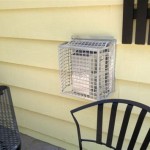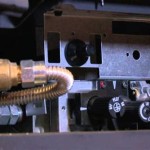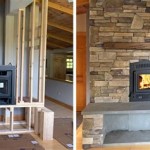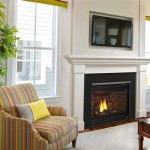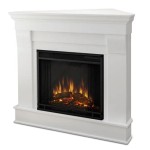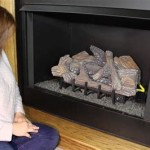How to Build an Outdoor Gas Fireplace Box
An outdoor gas fireplace box provides a designated and aesthetically pleasing structure to house a gas fireplace, enhancing the ambiance of outdoor living spaces. Constructing such a feature requires careful planning, adherence to safety regulations, and a solid understanding of building materials and techniques. This article outlines the process of building an outdoor gas fireplace box, focusing on key considerations and steps involved.
Planning and Design
Before commencing construction, it is crucial to develop a comprehensive plan. This involves considering the dimensions of the fireplace box, the surrounding landscape, and local building codes. Accurate measurements are paramount, as discrepancies can lead to structural instability or incompatibility with the selected gas fireplace insert.
First, the desired location for the fireplace box must be determined. Factors to consider include proximity to seating areas, prevailing wind direction, and adjacency to combustible materials. A safe distance from trees, fences, and overhanging structures is imperative to prevent fire hazards.
Next, select the type of gas fireplace insert that will be used. The dimensions and specifications of the insert will dictate the internal dimensions of the fireplace box. Ensure that the chosen insert is approved for outdoor use and complies with relevant safety standards.
Develop detailed blueprints or sketches depicting the fireplace box's dimensions, materials, and construction methods. These plans should include precise measurements for the base, walls, and any decorative elements. Consider the overall aesthetic of the surrounding area and design the fireplace box to complement existing architectural styles.
Verify local building codes and regulations pertaining to outdoor fireplaces. These codes may specify minimum clearances from property lines, required setbacks, and permissible materials. Obtain any necessary permits before starting construction to avoid potential fines or legal issues. Contacting the local gas company for permission and safety procedures is paramount. They can ensure proper gas line installation and safety checks.
Select durable and weather-resistant building materials. Common choices include concrete blocks, natural stone, brick, or treated lumber. The choice of material will influence the overall appearance and longevity of the fireplace box. Consider using fire-resistant materials for the inner walls of the box to provide an extra layer of protection against heat.
Plan for proper ventilation to prevent the build-up of carbon monoxide. Consult the gas fireplace insert's manual for specific ventilation requirements. Typically, this involves providing adequate airflow around the unit and ensuring that the flue (if applicable) is properly installed and unobstructed.
Design a stable and level foundation for the fireplace box. A concrete pad is a common choice, providing a solid base that can withstand the weight of the structure. The foundation should extend beyond the footprint of the fireplace box to provide additional support and prevent settling.
Construction Process
Once the planning phase is complete, the actual construction can begin. This involves preparing the site, building the foundation, constructing the walls, and installing the gas fireplace insert.
Prepare the site by clearing away any vegetation, debris, or obstructions. Level the ground and compact the soil to provide a stable surface for the foundation. Mark the outline of the foundation according to the dimensions specified in the plans.
Pour a concrete foundation according to local building codes. The foundation should be reinforced with rebar to provide additional strength and prevent cracking. Ensure that the foundation is level and allowed to cure completely before proceeding with the next steps. The concrete thickness will vary based on local requirements. Check local code before pouring.
Construct the walls of the fireplace box using the selected building materials. If using concrete blocks, stack them according to the plans, ensuring that each block is level and properly aligned. Mortar the blocks together to create a strong and stable structure. Reinforce corners and joints with additional mortar or metal straps.
If using natural stone or brick, apply a layer of mortar to the foundation and begin laying the stones or bricks in a pattern that complements the overall design. Use a level to ensure that each stone or brick is properly aligned. Cut stones or bricks as needed to fit around corners and edges. Fill the joints between the stones or bricks with mortar and smooth the surface.
Install fire-resistant materials on the inner walls of the fireplace box. This can be achieved by lining the walls with fire bricks or a refractory mortar. These materials will help to protect the structure from the intense heat generated by the gas fireplace insert.
Create an opening in the front of the fireplace box to accommodate the gas fireplace insert. The dimensions of the opening should match the specifications provided by the manufacturer of the insert. Ensure that the opening is properly aligned and squared before installing the insert.
Install the gas fireplace insert according to the manufacturer's instructions. Connect the gas line to the insert, ensuring that all connections are tight and leak-proof. Consult with a qualified gas technician to ensure that the gas line is properly installed and that all safety precautions are followed. The technician should pressure test the line for leaks.
Install any decorative elements, such as mantels, stone veneers, or concrete caps, according to the design plans. These elements can enhance the aesthetics of the fireplace box and create a more inviting atmosphere. Ensure that all decorative elements are securely attached to the structure.
After gas connection is complete, and decorative finishes applied, start the fireplace. Observe the flames and heat output. Ensure there are no lingering gas odors. Follow the fireplace manufacturer’s instructions for the initial burn-in process. Monitor the area around the fireplace for any signs of overheating or material degradation. If any issues are observed, immediately turn off the gas and contact a qualified technician.
Safety Considerations and Gas Line Installation
Safety is paramount when building and operating an outdoor gas fireplace. Adherence to safety guidelines and regulations is essential to prevent accidents and ensure the well-being of users.
Consult with a qualified gas technician for the installation and connection of the gas line. The technician will ensure that the gas line is properly sized, installed, and connected according to local codes and regulations. They will also perform a leak test to ensure that the gas line is free of leaks.
Install a gas shut-off valve near the fireplace box. This valve will allow you to quickly shut off the gas supply in case of an emergency. Ensure that the shut-off valve is easily accessible and clearly marked.
Provide adequate ventilation around the fireplace box to prevent the build-up of carbon monoxide. Carbon monoxide is a colorless, odorless gas that can be deadly if inhaled. Ensure that there is sufficient airflow around the fireplace box to prevent the build-up of this dangerous gas.
Maintain a safe distance between the fireplace box and any combustible materials. Keep trees, fences, and overhanging structures at least 10 feet away from the fireplace box. This will help to prevent fires and ensure the safety of the surrounding area.
Never use flammable liquids to start or accelerate a fire in the gas fireplace. Only use the gas supply provided for the fireplace. Using flammable liquids can create a dangerous situation and could result in serious injury or death.
Regularly inspect the gas fireplace and gas line for any signs of damage or wear. Check for leaks, cracks, or corrosion. If any damage is found, contact a qualified technician to repair or replace the affected components.
Keep a fire extinguisher nearby in case of an emergency. Ensure that the fire extinguisher is properly charged and that you know how to use it. In the event of a fire, evacuate the area and use the fire extinguisher to extinguish the flames. If the fire is too large to handle, call the fire department immediately.
Educate all users of the gas fireplace about safety precautions and operating procedures. Ensure that everyone knows how to properly turn on and off the gas supply, how to adjust the flame, and what to do in case of an emergency.
By following these guidelines and taking the necessary precautions, you can build and operate an outdoor gas fireplace safely and enjoyably. Remember that safety should always be your top priority when working with gas-powered appliances.

How To Build An Outdoor Fireplace Step By Guide Buildwithroman

How To Build An Outdoor Fireplace Step By Guide Buildwithroman

How To Build An Outdoor Fireplace

How To Build An Outdoor Fireplace Step By Guide Buildwithroman
:max_bytes(150000):strip_icc()/chrisjulia-971f3f9eb708447bbd364fc7f4a16280.jpg?strip=all)
10 Free Outdoor Fireplace Construction Plans

What Does It Take To Build An Outdoor Fireplace

Build An Outdoor Fireplace The Shed

Outdoor Fireplace Experts The 1 Dealer For Fireplaces

Outdoor Fireplaces Diy Kits Plans Cape Cod Ma Ri

How To Build A Gas Fire Pit Woodlanddirect Com
Related Posts

